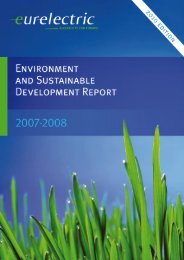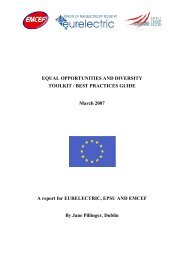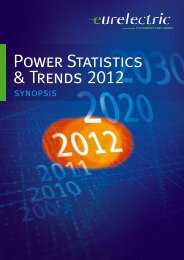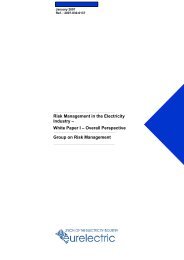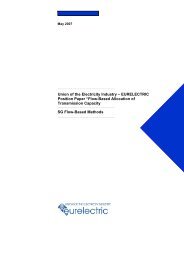Hydro in Europe: Powering Renewables - Full Report - Eurelectric
Hydro in Europe: Powering Renewables - Full Report - Eurelectric
Hydro in Europe: Powering Renewables - Full Report - Eurelectric
You also want an ePaper? Increase the reach of your titles
YUMPU automatically turns print PDFs into web optimized ePapers that Google loves.
Pumped storage facilities work as a huge electricity storage resource by charg<strong>in</strong>g or<br />
discharg<strong>in</strong>g power accord<strong>in</strong>g to the system’s demand. Compared to conventional<br />
reservoir-type hydropower plants, pumped storage power plants use the water stored <strong>in</strong><br />
the reservoirs repeatedly and do not need natural <strong>in</strong>flow <strong>in</strong>to the reservoirs.<br />
The role of pumped storage hydropower plants is twofold: balanc<strong>in</strong>g the grid for<br />
demand-driven fluctuations, and balanc<strong>in</strong>g generation-driven fluctuations – a new and<br />
<strong>in</strong>creas<strong>in</strong>gly important role due to the <strong>in</strong>crease of v-RES <strong>in</strong> the electricity system 32 .<br />
Services<br />
Like conventional reservoir-type hydropower plants, pumped storage power plants can<br />
provide the full range of grid-stabilis<strong>in</strong>g services, thanks to their ability to follow<br />
demand or generation fluctuations with<strong>in</strong> only a few m<strong>in</strong>utes.<br />
Therefore storage hydropower is a key tool for TSOs to ma<strong>in</strong>ta<strong>in</strong> a stable and balanced<br />
grid. Table 3 below summarises these grid-stabilis<strong>in</strong>g services, which are also called<br />
ancillary services.<br />
Back-up and reserve<br />
Quick start capability<br />
Black start capability<br />
Regulation and frequency<br />
response<br />
<strong>Hydro</strong>power plants have the ability to enter load <strong>in</strong>to an<br />
electrical system from a source that is not on-l<strong>in</strong>e.<br />
<strong>Hydro</strong>power can provide this service while not consum<strong>in</strong>g<br />
additional fuel, thereby ensur<strong>in</strong>g m<strong>in</strong>imal emissions.<br />
<strong>Hydro</strong>power’s quick-start capability is unparalleled, tak<strong>in</strong>g<br />
just a few m<strong>in</strong>utes – compared to 30 m<strong>in</strong>utes for other<br />
turb<strong>in</strong>es and hours for steam generation. This entails<br />
sav<strong>in</strong>gs <strong>in</strong> start-up and shut-down costs of thermal plant<br />
and allows for a steadier operation, sav<strong>in</strong>g fuel and<br />
extend<strong>in</strong>g plant life.<br />
<strong>Hydro</strong>power plants have the capability to run at a zero load.<br />
When loads <strong>in</strong>crease, additional power can be loaded<br />
rapidly <strong>in</strong>to the system to meet demand.<br />
Systems with available hydroelectric generation are able to<br />
restore service more rapidly than those solely dependent on<br />
thermal generation.<br />
<strong>Hydro</strong>power contributes to ma<strong>in</strong>ta<strong>in</strong><strong>in</strong>g the frequency<br />
with<strong>in</strong> the given marg<strong>in</strong>s by cont<strong>in</strong>uous modulation of<br />
active power and to meet moment-to-moment fluctuations<br />
<strong>in</strong> system power requirements.<br />
32 Generally, the predictability of v-RES is limited, even with highly sophisticated meteorological models.<br />
31



